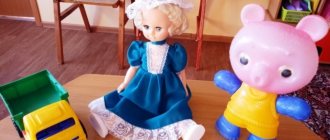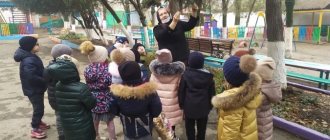Card file of autumn walks (senior group)
November.Card No. 5
1.Observation of rowan
Target:
consolidate knowledge about the benefits rowan brings to animals and birds in the cold season.
Progress of observation
So the first frost caught the rowan berries, they became tasty and soft. Animals and birds love rowan. A bear, if he finds it in the forest, hung with bunches of berries, will deftly tilt the flexible tree and enjoy its fruits with pleasure; The forest giants, elk, also like rowan berries. They reach the very top of the tree and eat fruits and branches with appetite. Berries that fall to the ground are picked up by voles, hedgehogs, chipmunks and squirrels. On pre-winter November days, flocks of bullfinches and waxwings arrive. They stick around the rowan and peck its juicy sweet berries. The birds peck quickly, dropping a lot of berries on the ground, then fly away further. Rowan saves many birds from hunger.
The crane's cry has already sounded, The garden has long since crumbled, And the bright clusters of rowan berries are still burning, hanging down.
2. “Sand cone” experiment.
Target:
show the property of sand - flowability.
Material: sand.
Procedure: Take a handful of dry sand and release it in a stream so that it falls in one place.
Gradually, a cone forms at the site of the fall, growing in height and occupying an increasingly larger area at the base. If you pour sand for a long time, first in one place, then in another, drifts occur; the movement of sand is similar to a current.
Conclusion: the property of sand is flowability.
3. Outdoor games
"Planes", "Sparrows and the Cat".
Target:
teach to quickly perform movements at the teacher’s signal and run in the indicated direction; cultivate friendliness.
4.Individual work
"Get in the basket."
Target:
develop accuracy and eye.
5. Didactic game
"Hide and Seek"
Target:
learn to find a tree by description, consolidate the ability to use prepositions in speech: behind, about, before, next to, because of, between, on; develop auditory attention.
6.Independent motor activity
November.
Card No. 5. Evening walk
1. Observation of migratory birds
Target:
expand ideas about migratory birds, about the changes in the life of birds in the fall, when cold weather sets in; foster love and care for birds.
The waters rustled like a fast stream, Birds flew away to warmer lands.
The teacher asks the children questions: What birds fly to warmer climes? Why are they doing that?
Birds gather in flocks and fly low above the ground. This means that they will soon fly away to warmer climes. Swallows will be the first to do this, since with the onset of cold weather the insects they catch in flight disappear. The last to fly away are ducks, geese, and cranes, as water bodies begin to freeze and they cannot find food in the water.
The teacher invites the children to complete the sentence:
• The sparrow is small, and the crane... (big).
• The duck is gray, and the swan... (white).
2. Didactic game “What kind of bird is this?”
Target:
clarify and expand ideas about bird life in autumn; describe birds by their characteristic features; cultivate a caring attitude towards birds.
Progress of the game:
Children are divided into 2 subgroups. Children of one subgroup describe the bird, and the other have to guess what kind of bird it is. You can use riddles. Then another subgroup asks their questions.
3. Word game “Do you remember these poems?”
Goal
: development of memory, attention, speech activity.
Progress of the game:
the teacher reads excerpts from poems familiar to the children. Children must pronounce the missing words.
Where did the sparrow have lunch? Don't stand too close:
At the zoo there are... (animals). I (tiger cub)
but not (…).
Wind across the sea (...)
And (...) customizes. Etc.
4. Outdoor game “Sparrows”. Target:
activation of the sound [h] in onomatopoeia;
development of dexterity. Progress of the game:
Children (sparrows) sit on a bench (in nests) and sleep. In response to the teacher’s words: “Sparrows live in a nest and everyone gets up early in the morning,” the children open their eyes and say loudly: “Tweet-chik-chik, chirp-chik-chik! They sing so joyfully."
After these words, the children scatter around the area. To the words of the teacher: “They flew to the nest!” - return to their places.
Labor activity:
Collecting pebbles on the site.
Target:
develop the ability to notice cleanliness in the area.



